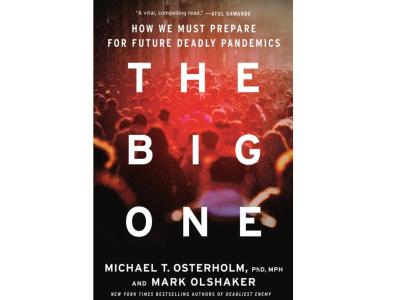Study says type of flu shot women received in 2009-10 didn't affect birth outcomes
Pregnant women who received the pandemic H1N1 influenza vaccine in 2009 or 2010 were no more likely to have adverse birth outcomes than women who received the seasonal flu shot at the time, according to a study published yesterday in Vaccine.
The report comes on the heels of a study suggesting that women who received a vaccine targeting the 2009 H1N1 virus 2 years in a row in 2010-2012 were more likely to have a spontaneous abortion (miscarriage) than women who had received the vaccine just once. That finding was also published this week in Vaccine. The authors said it did not show a causal relationship between the vaccine and miscarriages.
In the new study, researchers with the Kaiser Permanente Vaccine Study Center involved 5,365 pregnant women who had responded to a previous telephone survey of reactions to the 2009 H1N1 vaccine of trivalent seasonal flu vaccine (TIV). This time the researchers assessed adverse birth outcomes among these five immunization groups: TIV only, H1N1 only, H1N1 before TIV immunization, TIV before H1N1, and both immunizations given at the same time.
The adverse outcomes assessed were low preterm birth, very preterm birth, low birth weight, very low birth weight, smallness for gestational age, spontaneous abortions, stillbirths, and congenital anomalies.
The team said the results didn't vary significantly among the groups. In the H1N1-TIV comparison, the rates of adverse outcomes were similar for preterm births (6.37 versus 6.28 per 100 births), very preterm births (5.30 versus 8.29 per 1,000 births), low birth weight (4.19 versus 2.90 per 100 births), very low birth weight (4.54 versus 5.52 per 1,000 births), small for gestational age (9.99 versus 9.24 per 1,000 births), spontaneous abortion (7.10 versus 6.83 per 1,000 pregnancies), stillbirths (7.10 versus 4.57 per 1,000 pregnancies), and congenital anomalies (2.67 versus 2.43 100 births).
"Although constrained by small sample size, complex vaccine groups, and differential vaccine availability during 2009–2010, this study found no difference in adverse birth outcomes between H1N1 vaccine and TIV," the authors concluded.
Sep 13 Vaccine abstract
Sep 13 CIDRAP News story on report linking H1N1 vaccine with miscarriage risk
Malaria vaccine found effective against target strain, less so against other strains
A small study in which Plasmodium falciparum malaria parasites were used as a vaccine and administered in combination with drug treatment showed that volunteers were protected against later challenge with the same malaria strain but had low protection against two other strains, according to a report yesterday in BMC Medicine.
The trial, conducted in the Netherlands, involved a "well-characterized" P falciparum sporozoite strain called NF54, the report says. The researchers recruited 39 volunteers, all of whom were treated with chloroquine for 13 weeks. The 24 volunteers in the treatment group were bitten three times each by NF54-infected mosquitoes, while the 15 in the placebo group were bitten by uninfected mosquitoes.
Fourteen weeks after the end of chloroquine treatment, volunteers were challenged through the bites of infected mosquitoes that carried one of three P falciparum strains: NF54, NF135.C10, or NF166.C8. Starting 6 days after this challenge, the volunteers underwent daily blood tests to detect infection and were monitored for symptoms, and they were treated with curative drugs if infection was detected.
The primary study outcome was the time from challenge infection to detection of parasitemia. Of the 24 immunized volunteers, all 5 who were challenged with the NF54 strain were completely protected against it. But the immunization fully protected only 2 of 10 who were challenged with NF135.C10 and 1 of 9 challenged with NF166.C8, the report says.
In addition, the team found that post-immunization plasma from the volunteers had a significantly lower capacity to block development of the heterologous parasites (NF135.C10 and NF166.C8) in primary human liver cells, compared with the ability to block NF54.
Also, "whole genome sequencing showed that NF135.C10 and NF166.C8 have amino acid changes in multiple antigens" that were targeted by antibodies induced by the drug-and-immunization regimen, also known as chemoprophylaxis and sporozoites (CPS) immunization, the researchers said. They added that the few volunteers who were protected against heterologous challenge showed some of the strongest immune responses in in-vitro tests.
"Although highly protective against homologous parasites, NF54-CPS-induced immunity is less effective against heterologous parasite clones both in vivo and in vitro," the researchers conclude. "Our data indicate that whole sporozoite-based vaccine approaches require more potent immune responses for heterologous protection."
Sep 13 BMC Medicine report
Outbreaks in Switzerland, Taiwan as UK declares itself free of avian flu
The World Organization for Animal Health (OIE) recently noted H5N8 avian flu outbreaks in Switzerland and Taiwan, while the UK Department for Environment, Food & Rural Affairs (DEFRA) and Animal and Plant Health Agency (APHA) yesterday declared that country free from the strain while urging continued vigilance.
In Switzerland, veterinary officials reported three separate H5N8 detections in wild birds in the western part of the country, according to a Sep 11 OIE report. Mute swans in both Fribourg and Valais cantons were found dead on Aug 25, and mallards in Valais canton were found dead on Sep 9. All of the birds—three swans and two ducks total—tested positive for H5N8.
In Taiwan, H5N8 was detected in chickens killed at two slaughterhouses in Taipei. After slaughter, avian flu-like signs were observed, so samples were sent to a lab and tested positive. Forty-nine susceptible chickens were identified at one facility, and 27 at the other.
Officials said in an OIE report today, "The carcasses were destroyed and thorough cleaning and disinfection have been conducted in the abattoirs. After tracing back to the farm of origin, any positive results will be included in follow-up reports."
Sep 11 OIE report on Switzerland
Sep 14 OIE report on Taiwan
In the United Kingdom, meanwhile, the DEFRA/APHA declared the country free of avian flu after confirming 13 H5N8 outbreaks from December 2016 to June 2017.
"The Government Chief Vet has today announced the UK has met international requirements to declare itself free from Avian Influenza (AI) H5N8, but reiterated calls for all poultry keepers to remain vigilant for signs of disease, as there is a real and constant threat," the statement said.
"The disease continues to circulate in Europe and as winter approaches the risk of migratory wild birds infecting domestic poultry will rise. The UK was previously declared free of Avian Flu in April 2016 but the disease returned in December that year—so the government is not complacent."
Declaring the country free of avian flu means trade discussions on UK poultry and poultry products can restart, the two agencies said.
Sep 13 DEFRA/APHA statement
California data show siblings of kids with autism have lower vaccine uptake
The younger siblings of children with autism in southern California have decidedly lower levels of uptake of the measles, mumps, and rubella (MMR) vaccine, despite there being no connection whatsoever between vaccines and autism, according to a letter today in the New England Journal of Medicine.
Scientists at the University of California, San Diego, have tracked since 2009 the development of infants who have an older, full biologic sibling with a diagnosis of autism spectrum disorder, including vaccination data.
In their analysis of data from 206 families in southern California—71 of which had a child with autism spectrum disorder and 135 that did not—they found that MMR vaccine rates in younger siblings of those with autism were 83.1%, compared with 97.0% in the other group.
The researchers also noted that changes in vaccination behavior may relate to adverse vaccine reactions. Parents who had an older child with autism spectrum disorder retrospectively reported a higher rate of adverse reactions to vaccination among the older child than did those who did not (22.6% vs. 3.8%). Similarly, parents who had an older child with autism retrospectively reported a higher rate of adverse reactions in infant siblings (6.9% vs. 0.8%).
"These differences in reported reactions may reflect either a true increase or a recall bias, and they warrant larger prospective studies," the authors said.
Sep 14 N Engl J Med letter
Twenty-seven different viruses detected in semen
A research letter published yesterday in Emerging Infectious Diseases shows that human semen can host 27 different viruses. The study was conducted in the wake of the spread of Zika virus, which has been known to be sexually transmitted.
The authors of the study conducted a wide search on PubMed and found evidence of 27 viruses that can cause viremia documented in semen. For the vast majority of the viruses, information on genital fluid transmission rates and routes was lacking.
The 27 viruses come from diverse families. While recent outbreaks have shown that semen can house Zika and Ebola, the researchers found that other viruses, including Lassa fever, Rift Valley fever, and chikungunya, were also detected in semen.
"Given these findings, the following questions need to be addressed: which viruses are shed and remain viable in semen, for how long, and at what concentrations? The answers to these questions have implications for risks for sexual transmission and, therefore, embryonic infection, congenital disease, miscarriage, and effects on epidemiologic and transmission models," the authors conclude.
Sep 13 Emerg Infect Dis letter














